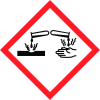MOD-06-5
AccuStandard, Inc
Revision date : 2015-08-06


Note: Ingredients listed on restricted chemical lists
EC/CAS
7732-18-5
Name of the chemical
Water, distilled, conductivity or of similar purity H2O
Concentration
N/A
General Information
Revision date
2015-08-06
Product name
MOD-06-5
Supplier name
AccuStandard, Inc
Emergency telephone
AccuStandard, Inc
Icons in SDS
Company Information
Company name
AccuStandard, Inc
E-mail address of the competent person responsible for the Safety Data Sheet
edocs@accustandard.com
GHS Information
Signal word
Danger
Hazard Codes
Hazard statements (CLP)
H302, H314, H318, H371
Hazard statements
Code
Statements
H302
Harmful if swallowed
H314
Causes severe skin burns and eye damage
H318
Causes serious eye damage
H371
May cause damage to organs
Precautionary statements
Code
Statements
P202
Do not handle until all safety precautions have been read and understood.
P262
Do not get in eyes, on skin, or on clothing.
P264
Wash ... thoroughly after handling.
P280
Wear protective gloves/protective clothing/eye protection/face protection.
P284
[In case of inadequate ventilation] Wear respiratory protection.
P331
Do NOT induce vomiting.
P338
Remove contact lenses, if present and easy to do. Continue rinsing.
P340
Remove victim to fresh air and keep at rest in a position comfortable for breathing.
P352
Wash with plenty of water/...
P404
Store in a closed container.
Section 2
SECTION 2: Hazards identification
2.2 Label elements
0 2 HEALTH 2 0 FLAMMABILITY - continued P284 - Respiratory Protection: If workplace exposure limit(s) of product or any component is exceeded (see TLV/PEL), or a risk assessment shows air-purifying respirators are appropriate, use of a NIOSH/MSHA approved air supplied respirator is advised. Use a full-face respirator with multi-purpose combination (US) or type ABEK (EN14387) respirator cartridges in absence of proper environmental control. Always use respirators and components tested and approved under appropriate government standards such as NIOSH (US) or CEN (EU). Engineering and/or administrative controls should be implemented to reduce exposure. P331 - Ingestion: Do NOT induce vomiting. Call a physician or poison control center immediately. Give victim a glass of water a little at a time. Never give anything by mouth to an unconscious person. If vomiting occurs spontaneously, lower head below waist to prevent fluid from entering the lungs. P338 - Eye contact: Immediately flush with plenty of water. After initial flushing, remove and contact lenses and continue flushing for at least 15 minutes. Assure adequate flushing by separating the eyelids with fingers. P340 - Inhalation: Remove to fresh air. If not breathing, give artificial respiration. If breathing is difficult, give oxygen. Get medical attention. P352 - Skin contact: Wash thoroughly with soap and water. Get medical attention if irritation develops or persists. P404 - Store in a tightly closed container.
Signal word
Danger 0
Hazard statements
H302 - Harmful if swallowed. (Acute toxicity, oral, category 4) H314 - Causes severe skin irritation. (Category 1B) H318 - Causes serious eye damage. (Eye damage/irritation, category 1) H371 - May cause lung damage. (Specific target organ toxicity - single exposure, inhalation) Category 2 Precautionary Codes: P202 - This product should only by used by persons trained in the safe handling of hazardous chemicals. P262 - Do not get in eyes, on skin or clothing. P264 - Wash thoroughly after handling. Do not take internally. Eye wash and safety equipment should be readily available. P280 - Protective gloves must be worn to prevent skin contact. - continued
2.3 Other hazards
2.2.1 - Symptom of Exposure Health/Environment Corrosive. May cause lung damage. (Specific target organ toxicity - single exposure, inhalation) Category 2 Depending on the intensity and duration of exposure, effects may vary from mild irritation to severe destruction of tissue. Material is extremely destructive to tissue of the eyes, mucous membranes upper respiratory tract and skin.
Potential health effects
Causes serious eye damage. (Eye damage/irritation, category 1) Causes severe skin irritation. (Category 1B) Harmful if swallowed. (Acute toxicity, oral, category 4) May be harmful if absorbed through the skin. (Acute toxicity, dermal, category 5) May be harmful if inhaled. (Acute toxicity, inhalation, category 5) 2.2.3 - Routes of Entry Inhalation, ingestion or skin contact. 2.2.4 - Carcinogenicity This product is or contains a component that is not listed (ACGIH, IARC, NTP, OSHA) as a cancer causing agent.

